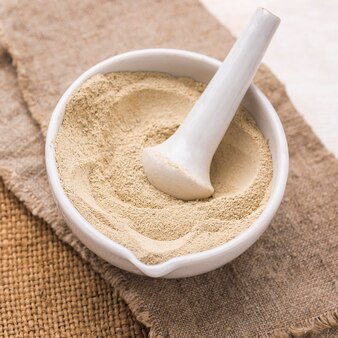⚠️ Medical Disclaimer
Important: This content is for informational and educational purposes only. It should not be used as a substitute for professional medical advice, diagnosis, or treatment. Always consult with a qualified healthcare provider before making changes to your diet, taking supplements, or if you have questions about a medical condition. Never disregard professional medical advice or delay seeking it because of information you read here.
Last Updated on February 13, 2024 by Grace Oluchi
Xanthan gum is a very, very popular modernist thickener, you can find it in many supermarkets. This is because a lot of people who run a gluten-free bakery, use xanthan gum as a thickener to do something that can be done normally by the protein gluten.
Xanthan gum is an ingredient that’s been used in the U.S. food supply for well over 50 years, yup quite a while. And even if you may never have heard of it, there’s actually not much that’s weird about this ingredient, it’s made through microbial fermentation much the same way brewer’s yeast is made. If you’ve ever had fermented vinegar or fermented sourdough, you’ll find Xanthan gum similar to them.
They take xanthomonas campestris and ferment it on sugars. The difference is it’s because it’s a commercial product, they tend to purify it, dry it, and carefully grate it, so you end up with what is more or less a white power, and this can make it unfamiliar, but not unnatural.
When you want to use it, you don’t have to pour so much, because a little goes a long way. Maybe as little as half a percent of the weight you’re liquid you intend to thicken. Just that amount will do the work. For example, about one gram is enough to thicken 200 grams of water, then you use a little shearing to disperse it into the water. And you’ll discover that just that little amount is enough to thicken that liquid.
It’s also commonly used as a food additive and thickening agent in a wide range of products, like sauces, dressings, dairy alternatives, bakery items, and gluten-free products. Keep reading cause I’ll dive into more details about it, including safety for diabetics, what it is, uses, health benefits, and more.
Is It Safe For Diabetics?


Xanthan gum is actually considered safe for diabetics Xanthan gum, of course when it is consumed in moderate amounts as a food additive. It is a soluble fiber that is not absorbed by the body, so it does not directly impact blood sugar levels. It also has a very low glycemic index, meaning it wouldn’t cause a rapid increase in your blood glucose levels. In fact, it may even have some potential health benefits for those with diabetes. This is because as a soluble fiber, it can help slow down the absorption of carbohydrates, which may contribute to better blood sugar control.
In addition, it can add bulk and texture to your meals, by making them more filling, and you’ll feel more satiated, which could potentially reduce overeating and calorie intake. So in general, it’s okay for diabetic patients to add it to their food, but it should be in fair amounts of course. Xanthan gum can become a part of your balanced diet, seeing that it’s even essential. However, it’s still important to ask your doctor if it’s really okay for you to consume it. Your doctor will always give you the right advice for you and your body. Because everyone is different and reacts differently to medical conditions, so even if Xanthan gum is safe for diabetics, it may not apply to all diabetics.
You’re going to love this article on type 2 diabetes, but keep on reading!
Here Is How Xanthan Gum Is Made In Simple Words


Firstly, I’ll tell you that it’s a type of complex carbohydrate called polysaccharide. It’s made from a type of bacteria named Xanthomonas Campestris, through the same process (fermentation) responsible for foods like cheese, wine, yogurt, and pickles. Then after that, it is isolated, and the bacteria is grown and eats the sugar it’s fed, resulting in Xanthan gum. The sources for those sugars might be wheat, corn, rice, or sugar.
Because it’s a gluey substance, they solidify, dry and purify it to form a powder. This can be done through processes such as spray drying or air drying. So after it’s a finished ingredient, they prepare it for use in foods.
Fascinating Health Benefits Xanthan Gum May Provide You
A Better Gut Health
Xanthan gum is a soluble fiber that could help promote regular bowel movements. It has a lubricating effect on the colon that can help your stools through properly. According to a 2017 re-evaluation, eating it in amounts ranging from 10.4 to 12.9 grams per day may eliminate constipation by adding bulk to stool with no adverse nutritional or physiological consequences.
Another 2022 study with a mixed experimental approach involving humans, animals, and human cells, showed that humans have the ability to break down xanthan gum, making it a “fermentable fiber” that could be considered prebiotic. This was explained by Keith Ayoob, an associate clinical professor of pediatrics and director of the nutrition clinic at the children’s Evaluation and Rehabilitation Center at Albert Einstein college of Medicine in New York City. Yes, it can support the growth of microbes, which contributes to overall digestive health.
However, it doesn’t necessarily mean that Xanthan gum is a form of dietary fiber. And it’s also currently not recognized as a prebiotic according to the ISAPP.
Many of these studies should be taken with a grain of salt as some of the studies were done in cells, or in animals using amounts that well exceed what you’d normally get in foods. That is why more research is needed to be done in humans before we can fully understand its role in gut health.
Lower Cholesterol
Higher doses of xanthan gum have been tested in scientific studies, and have been shown to help lower cholesterol levels for those at risk of heart attack or stroke. A study has five men consume 10 times the recommended amount per day for 23 days. Subsequent blood tests found that their cholesterol decreased by 10%.
Another study tested a viscous fiber konjac (a root vegetable) and xanthan gum on the estimated reduction of heart disease likelihood in people with at risk of heart disease. Several major risk factors for heart disease were reduced, including LDL (bad) blood cholesterol. Researchers estimated a lowered risk of heart disease by an average of 22%.
May lower blood sugar
Several studies have shown that consuming it in large doses can lower blood sugar levels. Xanthan gum is used as a replacement for gluten in many different baked foods. Unlike gluten, it doesn’t raise your blood sugar levels but helps keep them under control. it’s believed that it turns fluids in your stomach and small intestine into a viscous, gel-like substance. This slows digestion and affects how quickly sugar enters your bloodstream, reducing blood sugar spikes after eating.
Interesting studies were made concerning it. Such as the 12-week study. which had 9 men with diabetes and 4 without to eat a daily muffin. For six weeks of the study, the men ate muffins without Xanthan gum. For the other 6 weeks, they ate muffins with 12 grams of it. Their blood sugars were tested regularly, and both fasting and after-meal blood sugar levels in men with diabetes were significantly lower when consuming the Xanthan gum muffins.
Another interesting study showed 11 women’s blood sugars significantly reduced, after eating rice with added Xanthan gum, compared to eating rice without it.
Weight loss
People notice that they feel fuller after consuming and are less likely to overeat after consuming xanthan gum. This is because it can increase the feelings of fullness after eating and this could potentially help with weight management, by reducing a person’s overall calorie intake. And because of its abilities, it is widely used to replace and reduce the use of dietary fat in foods.
Regardless of these beliefs, there’s some conflicting evidence on the role xanthan gum plays in satiation. A group of European scientists reviewed three studies in relation to claims on xanthan gum and appetite control, and they didn’t find much evidence to support it.
Ease Swallowing difficulty
Xanthan gum is used to thicken liquids for those who have difficulty swallowing, such as older adults or people with neurological diseases. Dysphagia is the medical term for trouble with swallowing. Oftentimes those with dysphagia find it hard to eat or drink enough, which can worsen health issues. When it is added to products as a thickener, for people dealing with difficulty in swallowing, it helps increase the viscosity of foods and drinks to prevent choking. You will find it in shakes designed for older people with added vitamins and minerals.
Xanthan gum gives people with dysphagia access to a large array of food and drink options with better texture to make sure their nutrition and hydration needs are met in a tasty and familiar.
Gluten-free diet
Those with celiac disease or gluten sensitivity should avoid foods like wheat, barley, and rye as they naturally contain gluten. This can cause their diet to be too restrictive and boring because gluten is added to most baked goods for structure. It’s also used for airness in bread and moistness in cakes. But the great part is that xanthan gum can be used in place of gluten, to provide structure in baked goods. When there is no gluten in flour the result of the baked good will be flat and deflated, but xanthan gum can pretty much be replaced as it can create a similar structure to that of gluten.
So therefore those who must medically avoid gluten don’t have to miss out on some foods as they can purchase gluten-free foods in stores and enjoy it the same.
Some Other Interesting Health Benefits
Cancer-fighting properties
Animal studies on mice with melanoma showed that xanthan gum significantly slowed the growth of cancerous tumors leading to a prolonged life. Although there haven’t been any human studies, and further research on this topic is needed, so this current evidence may not apply to people.
Saliva substitute
It is sometimes used as a saliva substitute for those suffering from dry mouth or Sjogren’s syndrome. However, keep in mind that studies on its effectiveness have found mixed results.
Dental health
Xanthan gum may have oral health benefits, as it can increase saliva production and help cleanse the mouth.
Check out these articles about oral care
Difference between tooth caling and root planing
Are There Side Effects Concerning Xanthan Gum?
Generally, the only potential side effect of xanthan gum appears to be an upset stomach. Many animal studies found that large amounts can increase the frequency of stools and cause soft stools. In human beings, too much intake of xanthan gum leads to the following effects:
- Increased farts
- Softer stools
- Too much bathroom breaks
- Increased stool output
- Altered gut bacteria
These side effects are not common at all because it’ll take you to eat up to 15 grams. Which will be difficult to reach through a typical diet. So as much as it can improve your gut health as mentioned above, it could also improve it a little too much.
These People Need To Avoid Or Limit It
People with severe wheat, corn, soy, or dairy allergies
Xanthan gum is obtained from sugar, and the sugar can come from different places including wheat, corn, soy, and dairy. So, if you’re severely allergic to these products, you might want to avoid them, or basically anything with Xanthan gum. Allergic reactions can manifest as skin irritation, hives, itching, swelling, or respiratory symptoms such as difficulty breathing. So therefore, unless you can verify what source the xanthan gum came from, don’t eat it.
Those taking certain medications or planning surgery
Xanthan gum has the ability to lower blood sugar levels. This can be risky for those who are taking certain diabetes medications that can cause low blood sugar. It can also be dangerous for those who are awaiting surgery. In most cases, these people are fine with eating foods containing xanthan gum, but it’s important to avoid eating large amounts of it until its effects on blood sugar are more clarified.
People with digestive sensitivities
If you’re dealing with an inflammatory bowel disease like ulcerative colitis, eating larger amounts of xanthan gum could cause digestive discomfort. For most people with no preexisting digestive problems, any side effects are generally mild and will decrease over time as the body adjusts, according to experts. Roughly 15 grams or more could have a laxative effect, so anyone using this amount should only do so under their doctor’s supervision.
In cases where you have a history of bowel obstruction, you should avoid xanthan gum due to its fiber-like properties.
Premature infants
Do not give your infant xanthan gum because it can seriously cause it harm. In several cases, where Simply Thick (a xanthan gum-based thickener) was added to formula and breastmilk for premature infants, the infant developed necrotizing enterocolitis, a life-threatening disease that causes the intestines to become inflamed, damaged, and start to die. Never use it in anything that your infant will come in contact with, since their guts are still developing.
Products You Probably Didn’t Know Contained Xanthan Gum
Food products
Xanthan gum can improve the texture, consistency, flavor, and appearance and prolong the freshness of foods. It can help stabilize foods, and also help them withstand different temperatures and pH levels. You would also enjoy seeing foods not separate and flow smoothly out of their containers. Many people use it when preparing gluten-free meals as it can provide the elasticity and fluffiness that gluten normally gives traditional baked goods.
Here’s my list of types of foods that contain xanthan gum.
- Salad dressing
- Bakery products
- Fruit juices
- Soups
- Sauces and gravies
- Canned soups and broths
- Dips and spreads
- Syrups
- Gluten-free products
- Low-fat foods
- Frozen meals and convenience foods
- Icecream
Personal care products
Yup, Xanthan gum exists in most beauty and personal products you use. It’s in there to allow easy movement when you, for example, press them out. It also allows solid particles to be suspended in liquids.
Some common products you use that contain it:
- Lotions
- Toothpaste
- Shampoo
- Creams
Industrial Products
Many industries use xanthan gum in their products, due to its ability to enable the products to withstand different temperatures and pH levels, cling to surfaces, and thicken liquids, all while maintaining a good flow.
Some interesting examples
- Paints
- Fungicides, insecticides and herbicides
- Tile, oven, grout, and toilet bowl cleaners
- Wall paper glue
- Cement
- Fluids used in oil drilling
Using Xanthan Gum As A Dietary Supplement, (wrong or right move)
Actually, it wasn’t made for that. In some words, like every simple words, it is a thickener agent. Not something to add to the list of things you do to stay healthy. Yes, it’s possible you’ll gain some health benefits and it’s not particularly dangerous, but you shouldn’t make that choice. So yes, it’s something you shouldn’t do.
Xanthan gum is great, due to its multipurpose abilities, but it’s important to know that some people with some medical conditions are advised to limit or stay away from it. Just as mentioned above, it could worsen these conditions. In fact you’re not even going to be able to meet up with whatever goals you set with it, because in comparison with dietary supplements, it’s very unlikely you’d eat large amounts of it at any given time because it’s used in such small amounts in most foods.
And eating it directly is also a no no.
Because it is not typically consumed on its own as a standalone ingredient due to its gummy and thickening properties. Directly eating it can be disgusting and consuming it directly could potentially lead to gastrointestinal discomfort, such as bloating or diarrhea. And you definitely don’t want that. What’s best is to use it as an ingredient in recipes where it serves its intended purpose, such as thickening sauces, gravies, soups, or baked goods. That’s the only good and safe way to eat it.

